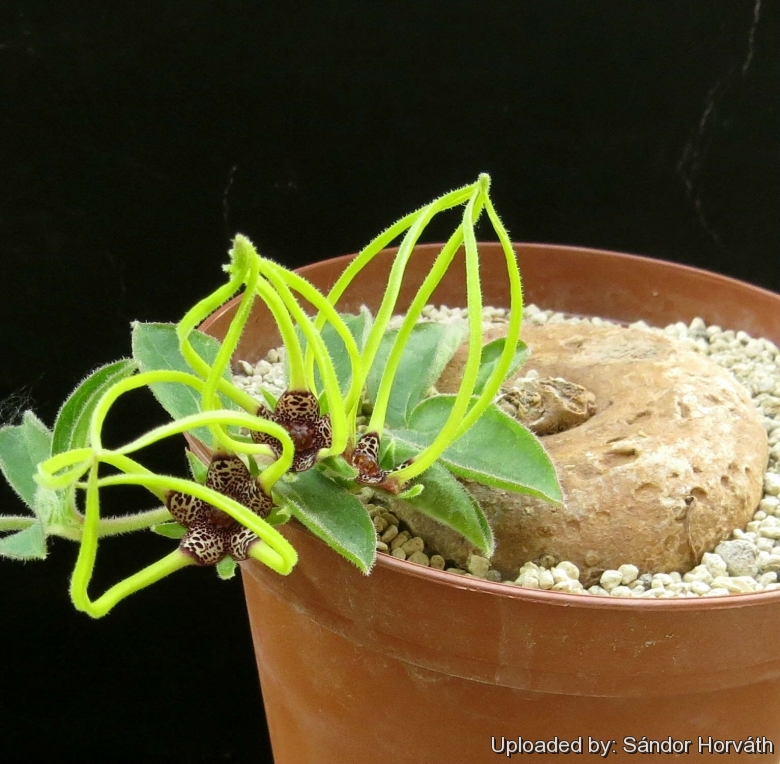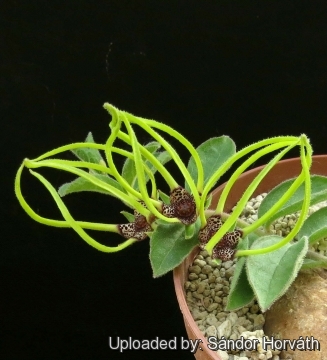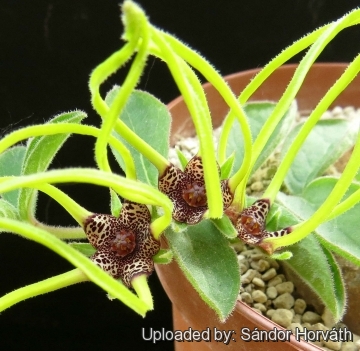
Brachystelma megasepalum Photo by: Sándor Horváth
Origin and Habitat: Zambia, Tanzania.
Synonyms:
Description: Brachystelma megasepalumSN|32328]]SN|32322]] is a dwarf geophyte herb with a few aerial shoots 20 cm cm long, from a small flattish tuber (caudex) the top of which may sometimes be seen above ground. As the species name it implies, it has comparatively large sepal. It has peculiar lantern or cage-like flowers with brown-violet spotted with yellow-green corolla-tube and pleasantly contrasting green-yellow narrow lobes remaining joined at their tips, it cannot be confused with any other species in est Africa. In terms of the scent it has been described like an intense smell of dung.
Tuber (caudex): Round and flattened, mostly underground, 5-6 cm in diameter, with yellow flesh.
Stem: Aerial shoot solitary to several, up to 20 cm high, slender, filiform, erect decumbent-creeping.
Leaves: Arranged in an alternate or opposite position, obovate, blade 20-30 mm long, 12-18 mm broad, shortly hairy. Petiole 10-15 mm long.
Inflorescences (racemes): Sessile, from every other lateral, 4-flowered. Pedicels 20-25 mm long.
Flowers: Cage-like, rarely star-like. Sepals triangular, to 10 mm long and 3 mm broad. Corolla-tubee shallow 10-12 mm in diameter, inside brown-violet, spotted with yellow-green. Corolla-lobes triangular-linear, 25-30 mm, apically united and forming a globose cage, or free, green-yellow, margins revolute. Corona sessile, 3.5 x 2 mm, yellowish, mottled with red-brown
Fruits (follicles): One or two per flower, thickly fusiform, up to 50 mm long and 15 mm in diameer.
Seeds: About 10 mm long, and 7 mm broad..
Related species: It is closely related with Brachystelma buchannii and Brachystelma foetidumSN|32322]]SN|32328]].
Bibliography: Major references and further lectures
1) Focke Albers, Ulrich Meve “Illustrated Handbook of Succulent Plants: Asclepiadaceae: Asclepiadaceae”, Volume 4 Springer Science & Business Media, 2002
 Brachystelma megasepalum Photo by: Sándor Horváth
Brachystelma megasepalum Photo by: Sándor Horváth Brachystelma megasepalum Photo by: Sándor Horváth
Brachystelma megasepalum Photo by: Sándor HorváthCultivation and Propagation: In cultivation the plants are usually grown in semi shade, with the tubers wholly or (preferably) partially exposed to prevent scorching and rotting of the roots. This plant can take a good deal of water during active growth and should be watered only when not dormant. Keep dryish in winter. It should be overwintered in the greenhouse at temperatures over 12°C (avoid letting temperatures drop lower than 5° C). Use a very draining but rich soil. An error in cultivation may produce unsightly holes in the tuber.
*Reproduction: This species can be reproduced by seeds. Sow seeds in summer in a well drained medium.












